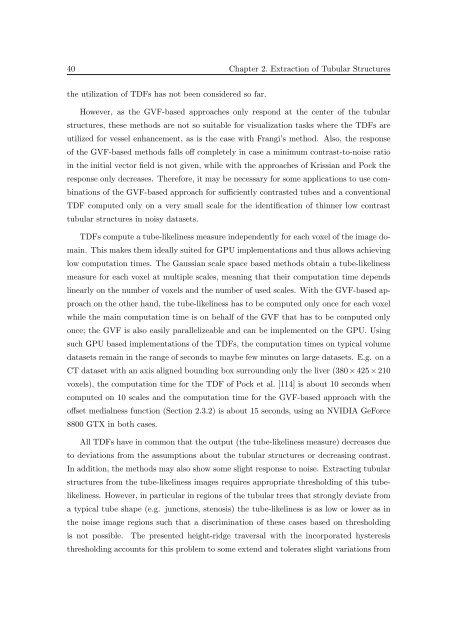Segmentation of 3D Tubular Tree Structures in Medical Images ...
Segmentation of 3D Tubular Tree Structures in Medical Images ...
Segmentation of 3D Tubular Tree Structures in Medical Images ...
Create successful ePaper yourself
Turn your PDF publications into a flip-book with our unique Google optimized e-Paper software.
40 Chapter 2. Extraction <strong>of</strong> <strong>Tubular</strong> <strong>Structures</strong><br />
the utilization <strong>of</strong> TDFs has not been considered so far.<br />
However, as the GVF-based approaches only respond at the center <strong>of</strong> the tubular<br />
structures, these methods are not so suitable for visualization tasks where the TDFs are<br />
utilized for vessel enhancement, as is the case with Frangi’s method. Also, the response<br />
<strong>of</strong> the GVF-based methods falls <strong>of</strong>f completely <strong>in</strong> case a m<strong>in</strong>imum contrast-to-noise ratio<br />
<strong>in</strong> the <strong>in</strong>itial vector field is not given, while with the approaches <strong>of</strong> Krissian and Pock the<br />
response only decreases. Therefore, it may be necessary for some applications to use comb<strong>in</strong>ations<br />
<strong>of</strong> the GVF-based approach for sufficiently contrasted tubes and a conventional<br />
TDF computed only on a very small scale for the identification <strong>of</strong> th<strong>in</strong>ner low contrast<br />
tubular structures <strong>in</strong> noisy datasets.<br />
TDFs compute a tube-likel<strong>in</strong>ess measure <strong>in</strong>dependently for each voxel <strong>of</strong> the image doma<strong>in</strong>.<br />
This makes them ideally suited for GPU implementations and thus allows achiev<strong>in</strong>g<br />
low computation times. The Gaussian scale space based methods obta<strong>in</strong> a tube-likel<strong>in</strong>ess<br />
measure for each voxel at multiple scales, mean<strong>in</strong>g that their computation time depends<br />
l<strong>in</strong>early on the number <strong>of</strong> voxels and the number <strong>of</strong> used scales. With the GVF-based approach<br />
on the other hand, the tube-likel<strong>in</strong>ess has to be computed only once for each voxel<br />
while the ma<strong>in</strong> computation time is on behalf <strong>of</strong> the GVF that has to be computed only<br />
once; the GVF is also easily parallelizeable and can be implemented on the GPU. Us<strong>in</strong>g<br />
such GPU based implementations <strong>of</strong> the TDFs, the computation times on typical volume<br />
datasets rema<strong>in</strong> <strong>in</strong> the range <strong>of</strong> seconds to maybe few m<strong>in</strong>utes on large datasets. E.g. on a<br />
CT dataset with an axis aligned bound<strong>in</strong>g box surround<strong>in</strong>g only the liver (380 × 425 × 210<br />
voxels), the computation time for the TDF <strong>of</strong> Pock et al. [114] is about 10 seconds when<br />
computed on 10 scales and the computation time for the GVF-based approach with the<br />
<strong>of</strong>fset medialness function (Section 2.3.2) is about 15 seconds, us<strong>in</strong>g an NVIDIA GeForce<br />
8800 GTX <strong>in</strong> both cases.<br />
All TDFs have <strong>in</strong> common that the output (the tube-likel<strong>in</strong>ess measure) decreases due<br />
to deviations from the assumptions about the tubular structures or decreas<strong>in</strong>g contrast.<br />
In addition, the methods may also show some slight response to noise. Extract<strong>in</strong>g tubular<br />
structures from the tube-likel<strong>in</strong>ess images requires appropriate threshold<strong>in</strong>g <strong>of</strong> this tubelikel<strong>in</strong>ess.<br />
However, <strong>in</strong> particular <strong>in</strong> regions <strong>of</strong> the tubular trees that strongly deviate from<br />
a typical tube shape (e.g. junctions, stenosis) the tube-likel<strong>in</strong>ess is as low or lower as <strong>in</strong><br />
the noise image regions such that a discrim<strong>in</strong>ation <strong>of</strong> these cases based on threshold<strong>in</strong>g<br />
is not possible. The presented height-ridge traversal with the <strong>in</strong>corporated hysteresis<br />
threshold<strong>in</strong>g accounts for this problem to some extend and tolerates slight variations from















